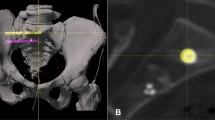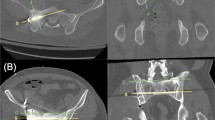Abstract
Introduction
The objective of this study is to report the institutions experiences with standardized 2D computer-navigated percutaneous iliosacral screw placement (CNS), as well as the conventional fluoroscopically assisted screw placement method (CF) over a period of 10 years.
Patients and methods
A total of 604 patients with sacral fractures (OTA B and C) were treated at the institution. Cases with both, a preoperative and postoperative CT scan were included for further analysis. With this prerequisite, a total of 136 cases were included. The quality of screw positioning, length of operation and intraoperative radiation exposure were recorded and compared. Moreover, it was analyzed whether the presence of dysmorphic sacra influenced the precision of screw positioning.
Results
Two hundred and thirty-two screws were implanted in 136 patients (100 navigated, 36 conventional). The duration of the average procedure was similar in the two groups [49.8 min (p = 0.7) conventional group (CF) vs. 48.0 min computer-navigated (CNS) group]. With computer navigation, radiation exposure was significantly reduced by almost half [128.3 vs. 65.2 s (p = 0.023)]. Screw placement was more accurate in the navigation group (79.03% CF vs. 86.47% CNS). The presence of dysmorphic sacral foramina or an increased alar slope increased the incidence of screw malpositioning.
Conclusion
The conventional percutaneous method and a standardized 2D navigated method have similar rates of malpositioning. Dysmorphic upper sacral foramina and increased alar slope were identified as risk factors for screw malpositioning. Radiation exposure rates were reduced by half when using computer navigation. Therefore, computer navigation in iliosacral screw placement is recommended as method of choice.


Similar content being viewed by others
References
Buller LT, Best MJ, Quinnan SM. A nationwide analysis of pelvic ring fractures: incidence and trends in treatment, length of stay, and mortality. Geriatr Orthop Surg Rehabil. 2016;7:9–17. https://doi.org/10.1177/2151458515616250.
Richter PH, Gebhard F, Dehner C, Scola A. Accuracy of computer-assisted iliosacral screw placement using a hybrid operating room. Injury. 2016;47:402–7. https://doi.org/10.1016/j.injury.2015.11.023.
Bastian JD, Jost J, Cullmann JL, et al. Percutaneous screw fixation of the iliosacral joint: optimal screw pathways are frequently not completely intraosseous. Injury. 2015;46:2003–9. https://doi.org/10.1016/j.injury.2015.06.044.
Hopf JC, Krieglstein CF, Müller LP, Koslowsky TC. Percutaneous iliosacral screw fixation after osteoporotic posterior ring fractures of the pelvis reduces pain significantly in elderly patients. Injury. 2015;46:1631–6. https://doi.org/10.1016/j.injury.2015.04.036.
Lindsay A, Tornetta P, Diwan A, Templeman D. Is closed reduction and percutaneous fixation of unstable posterior ring injuries as accurate as open reduction and internal fixation? J Orthop Trauma. 2016;30:29–33. https://doi.org/10.1097/BOT.0000000000000418.
Radetzki F, Wohlrab D, Goehre F, et al. Anatomical conditions of the posterior pelvic ring regarding bisegmental transverse sacroiliac screw fixation: a 3D morphometric study of 125 pelvic CT datasets. Arch Orthop Trauma Surg. 2014;134:1115–20. https://doi.org/10.1007/s00402-014-2022-8.
Routt ML, Simonian PT, Agnew SG, Mann FA. Radiographic recognition of the sacral alar slope for optimal placement of iliosacral screws: a cadaveric and clinical study. J Orthop Trauma. 1996;10:171–7.
Routt ML, Simonian PT, Mills WJ. Iliosacral screw fixation: early complications of the percutaneous technique. J Orthop Trauma. 1997;11:584–9.
Theologis AA, Burch S, Pekmezci M. Placement of iliosacral screws using 3D image-guided (O-arm) technology and stealth navigation: comparison with traditional fluoroscopy. Bone Jt J. 2016;98–B:696–702. https://doi.org/10.1302/0301-620X.98B5.36287.
Zwingmann J, Hauschild O, Bode G, et al. Malposition and revision rates of different imaging modalities for percutaneous iliosacral screw fixation following pelvic fractures: a systematic review and meta-analysis. Arch Orthop Trauma Surg. 2013;133:1257–65. https://doi.org/10.1007/s00402-013-1788-4.
Marsh JL, Slongo TF, Agel J, et al. Fracture and dislocation classification compendium—2007: Orthopaedic Trauma Association classification, database and outcomes committee. J Orthop Trauma. 2007;21:1–133.
Matta JM, Saucedo T. (1989) Internal fixation of pelvic ring fractures. Clin Orthop 242:83–97.
Smith HE, Yuan PS, Sasso R, et al. An evaluation of image-guided technologies in the placement of percutaneous iliosacral screws. Spine. 2006;31:234–8.
Lee JJ, Rosenbaum SL, Martusiewicz A, et al. Transsacral screw safe zone size by sacral segmentation variations. J Orthop Res. 2015;33:277–82. https://doi.org/10.1002/jor.22739.
Letournel E. Pelvic fractures. Injury. 1978;10:145–8.
Carlson DA, Scheid DK, Maar DC, et al. Safe placement of S1 and S2 iliosacral screws: the “vestibule” concept. J Orthop Trauma. 2000;14:264–9.
Wagner D, Kamer L, Sawaguchi T, et al. Sacral bone mass distribution assessed by averaged three-dimensional CT models: implications for pathogenesis and treatment of fragility fractures of the sacrum. J Bone Jt Surg Am. 2016;98:584–90. https://doi.org/10.2106/JBJS.15.00726.
Mendel T, Appelt K, Kuhn P, Suhm N. Bony sacroiliac corridor. A virtual volume model for the accurate insertion of transarticular screws. Unfallchirurg. 2008;111:19–26. https://doi.org/10.1007/s00113-007-1386-4.
Gardner MJ, Morshed S, Nork SE, et al. Quantification of the upper and second sacral segment safe zones in normal and dysmorphic sacra. J Orthop Trauma. 2010;24:622–9. https://doi.org/10.1097/BOT.0b013e3181cf0404.
Tonetti J, Cloppet O, Clerc M, et al. Implantation of iliosacral screws. Simulation of optimal placement by 3-dimensional X-ray computed tomography. Rev Chir Orthop Reparatrice Appar Mot. 2000;86:360–9.
Zwingmann J, Konrad G, Mehlhorn AT, et al. Percutaneous iliosacral screw insertion: malpositioning and revision rate of screws with regards to application technique (navigated vs. conventional). J Trauma. 2010;69:1501–6. https://doi.org/10.1097/TA.0b013e3181d862db.
Verbeek J, Hermans E, van Vugt A, Frölke JP. Correct positioning of percutaneous iliosacral screws with computer-navigated versus fluoroscopically guided surgery in traumatic pelvic ring fractures. J Orthop Trauma. 2016;30:331–5. https://doi.org/10.1097/BOT.0000000000000502.
Zwingmann J, Südkamp NP, König B, et al. Intra- and postoperative complications of navigated and conventional techniques in percutaneous iliosacral screw fixation after pelvic fractures: results from the German Pelvic Trauma Registry. Injury. 2013;44:1765–72. https://doi.org/10.1016/j.injury.2013.08.008.
Herman A, Keener E, Dubose C, Lowe JA. Simple mathematical model of sacroiliac screws safe-zone-easy to implement by pelvic inlet and outlet views. J Orthop Res. 2016;35(7):1478–84. https://doi.org/10.1002/jor.23396.
Abdullah KG, Bishop FS, Lubelski D, et al. Radiation exposure to the spine surgeon in lumbar and thoracolumbar fusions with the use of an intraoperative computed tomographic 3-dimensional imaging system. Spine. 2012;37:E1074–8. https://doi.org/10.1097/BRS.0b013e31825786d8.
Gebhard FT, Kraus MD, Schneider E, et al (2006) Does computer-assisted spine surgery reduce intraoperative radiation doses? Spine 31:2024–2027. https://doi.org/10.1097/01.brs.0000229250.69369.ac(discussion 2028).
Funding
There is no funding source.
Author information
Authors and Affiliations
Contributions
JBG, MJH and LGG developed the study design. JBG, ML, DT performed the literature research. JBG, ML, MJH and LGG collected the data and interpreted the data. JBG, MJH, LGG and DT wrote the paper. JMR and WL were responsible for critical revision.
Corresponding author
Ethics declarations
Conflict of interest
The authors declare that they have no conflict of interest.
Ethical approval
All procedures involving human participants were in accordance with the ethical standards of the institutional and with the 1964 Helsinki declaration and its later amendments or comparable ethical standards. As this study was retrospective, formal consent was not required.
Rights and permissions
About this article
Cite this article
Berger-Groch, J., Lueers, M., Rueger, J.M. et al. Accuracy of navigated and conventional iliosacral screw placement in B- and C-type pelvic ring fractures. Eur J Trauma Emerg Surg 46, 107–113 (2020). https://doi.org/10.1007/s00068-018-0990-z
Received:
Accepted:
Published:
Issue Date:
DOI: https://doi.org/10.1007/s00068-018-0990-z




